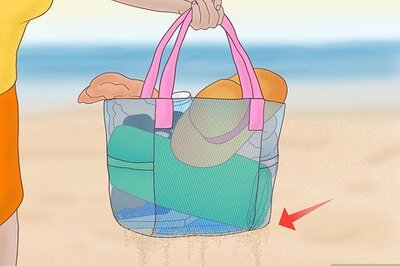
views
The use of sustainable fabrics in the apparel industry has become a popular trend as more consumers demand eco-friendly and socially responsible clothing options. Sustainable fabrics are those that are produced using materials and processes that minimize negative impacts on the environment and on people.
“Meanwhile, world over buyers are becoming increasingly aware of the damage Fast Fashion is doing to the environment. This has led them to become conscious of what they are buying. They are opting for a natural, sustainable material that is Earth and environment friendly. We at Peepul Tree believe that India has a lot to gain from this trend as we are home to a large number of traditional weaves and crafts that champion sustainability. India’s crafters who are carrying forward age-old legacies use environment friendly materials that are deeply connected to the Earth. These products which are handmade and unique are of the finest quality and are celebrated by connoisseurs,” adds Menon.
Organic cotton, hemp, bamboo, and recycled polyester are some examples of sustainable fabrics. Organic cotton is grown without the use of harmful chemicals, making it a popular choice for t-shirts, jeans, and other casual wear. Hemp is a fast-growing crop that requires little water and no pesticides, and it can be used to create a variety of fabrics, including denim, canvas, and twill. Bamboo is a renewable resource that requires minimal water and no pesticides. It can be used to create soft, breathable fabrics that are perfect for active wear and loungewear. Recycled polyester, made from post-consumer waste like plastic bottles, is often used in athletic wear and outdoor clothing.
The use of sustainable fabrics has several benefits, including reducing waste, minimizing the use of harmful chemicals, and conserving resources. Additionally, sustainable fabrics can be produced using fair labor practices, supporting communities and promoting social responsibility. By using sustainable fabrics, the apparel industry can reduce its environmental footprint and provide consumers with ethical and eco-friendly options.
Deepak Ramakrishna, co-founder, Suspire, says, “The use of sustainable fabrics in the apparel industry has several benefits, both for the environment and for society as a whole. These fabrics are made using materials and processes that have a lower impact on the environment. For example, organic cotton is grown without the use of synthetic pesticides and fertilizers, which reduces the amount of harmful chemicals that are released into the soil and water.”
Sustainable fabrics often require fewer natural resources to produce, such as water and land. This helps to conserve these resources and reduce the strain on ecosystems.
“A very important point to note is that most sustainable fabrics are produced using fair trade and ethical labour practices, which helps to support workers in the textile industry and promotes social responsibility. As consumers, we have become accustomed to a “disposable” culture in which we prioritize the initial cost of clothing over its long-term value. Instead, we should focus on investing in products that will endure, rather than purchasing clothes for a single event,” adds Ramakrishna.
The Growing Trend of Eco-Friendly Fabrics
Organic cotton, viscose, Lenzing modal, Lenzing satin and linen have been some of our most used sustainable textile options. These textiles are perennially conducive and that’s why these fabrics work well with our consumers.
“The use of organic cotton in a knit form with eco-friendly digital printing was made available in two pullover styles for our customers. Those performed really well amongst our audience.
As for our latest denim drop, we have used Tencel and organic cotton denim blends in shades of indigo and charcoal. To achieve each particular shade, the washing and dyeing practices utilized conscious use of water and eco-friendly dyes. The ink used for printing is GOTS certified and sustainable. All trims used are reusable or upcycle-worthy,” says Niharika Raut, founder and creative head, Around The City.
These conscious practices are the need of the hour for fashion brands across the globe. “We need to embrace them to lessen our carbon footprint. And yes, we have to put in more time and effort in order to achieve what we aim for. But in the long run, these are the textiles for the win. The return on these investments is much more in the future as compared to the effort and capital put in towards developing and launching each conscious collection now. So some may put sustainable brands under the luxury bracket now, but in the long run, these are the brands that will survive. Fast fashion is long gone and it’s now the time for slow and conscious fashion,” opines Raut.
Luxury brands focus on using high-quality materials for their production as compared to the high street or mass-produced products. “As quality materials are known to last longer, Luxury Pop as an e-commerce platform gives them a second life/many lives during their life cycle span by the process of retailing of the said luxury goods which leads to slow fashion consumption. As India’s pioneering marketplace for the retail of pre-owned luxury goods, Luxury Pop encourages the idea of reusing and passing on luxury items by educating buyers on how they can reduce their pre-owned footprint thus leading to the increasingly growing circular fashion movement,” says Puneet Anand, Founder, Luxury Pop.
When it comes to consciousness regarding the environment, there are numerous factors and practices we can adopt to make our product sustainable, and less harmful for the earth. From the make of the actual product, its longevity, its relationship with the wearer, its care and of course the packaging it comes in, are all key points at which change can be implied.
Read all the Latest Lifestyle News here














Comments
0 comment